1930s
Anti-Mosquito Leggings
I'm a bit surprised these anti-mosquito leggings never (to my knowledge) caught on, because if they actually worked then who cares if they looked dorky. Then again, I suppose DEET had already been discovered.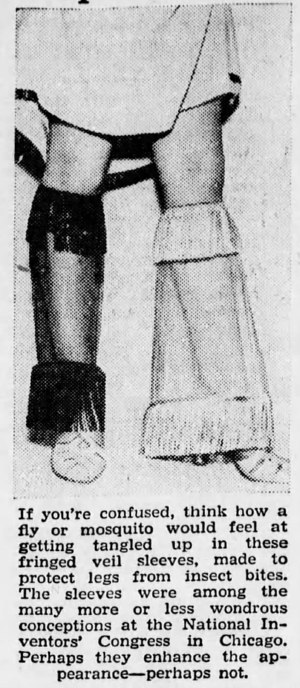
Danville Morning News - Apr 6, 1937

Pittsburgh Post-Gazette - Apr 1, 1937

Harrisburg Evening News - Apr 2, 1937
Posted By: Alex - Sun Feb 12, 2017 -
Comments (2)
Category: Fashion, Insects and Spiders, 1930s
World’s Oldest Active Salesman: 1939
Jump to 3:12 for this feature. I hope I move as good at that age as Charles Thurston did.
Posted By: Paul - Mon Jan 30, 2017 -
Comments (1)
Category: Business, Human Marvels, 1930s, Cars
Radium Cap
I'm guessing that if this actually worked to cure headaches it was because of the placebo effect. Although radium does, of course, produce heat, which might help a headache. But if there was enough radium in the cap to feel noticeably warm, it must have been incredibly dangerous.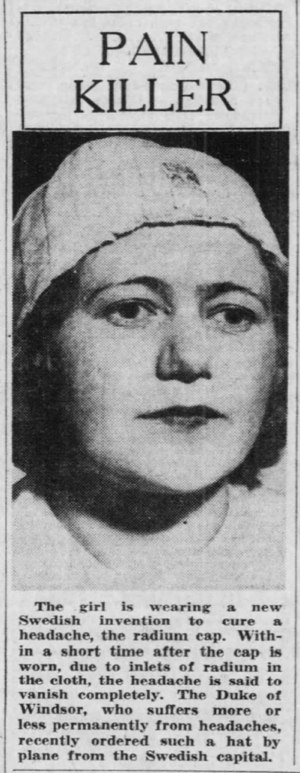
Pittsburgh Post-Gazette - June 11, 1937
Posted By: Alex - Sat Jan 21, 2017 -
Comments (21)
Category: Atomic Power and Other Nuclear Matters, Headgear, 1930s
Mount Mihara: Japan’s Suicide Volcano
If you really have to do yourself in, suicide by volcano sounds pretty dramatic and exciting.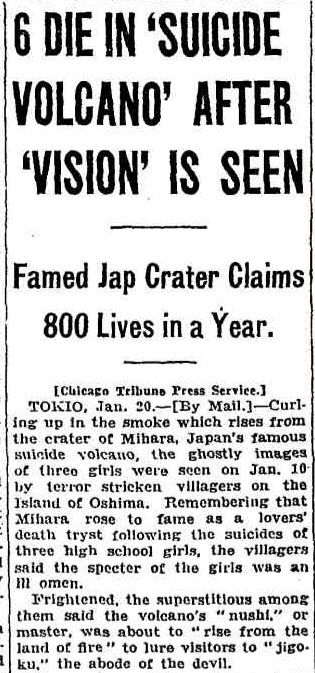
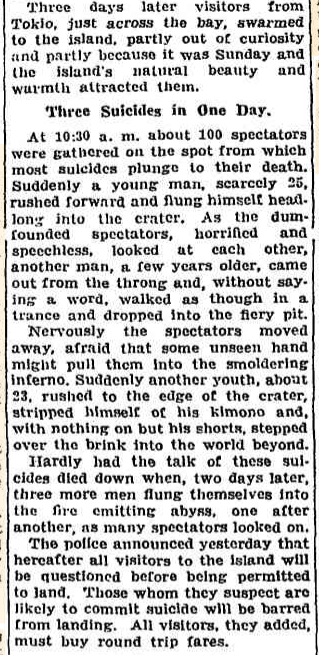
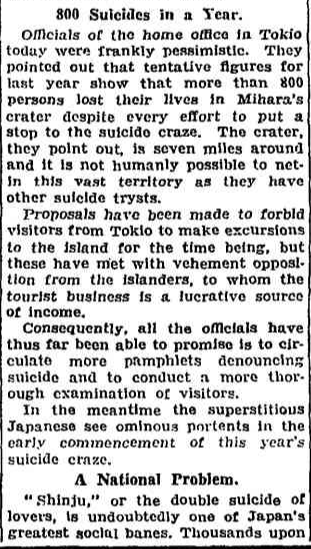
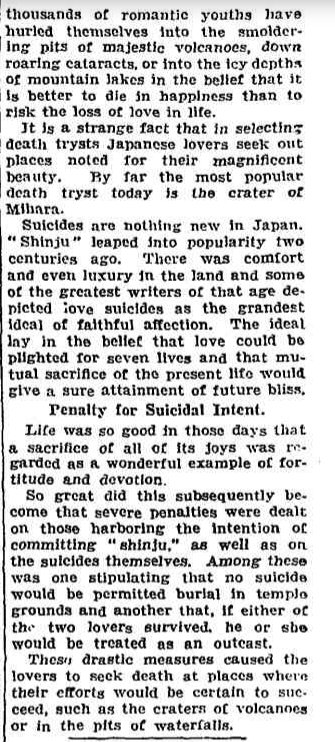
Original article here.
Wikipedia info here.
Posted By: Paul - Fri Jan 20, 2017 -
Comments (4)
Category: Death, Suicide, 1930s, Asia
Miniature Driving School
Back in the 1930s, if a Detroit judge suspected a driver was mentally unfit to be on the road, he might send the driver to see Dr. Lowell Selling, who would test the driver using a miniature street intersection to simulate various situations. However, I'm not sure what exactly this testing involved, beyond that vague description.I found a brief note about Dr. Selling in the Law Enforcement Executive Forum (2008, pdf, p.51):
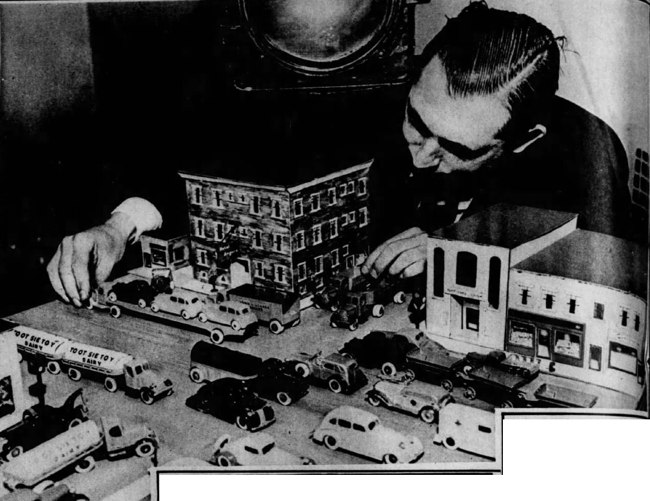
St. Louis Post-Dispatch - Sep 13, 1936
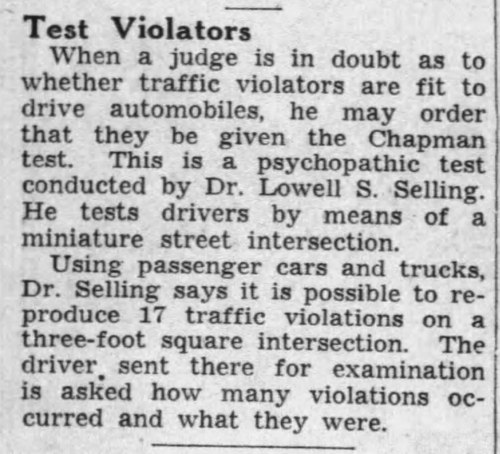
Palladium-Item - Oct 21, 1936
Posted By: Alex - Thu Jan 19, 2017 -
Comments (2)
Category: Motor Vehicles, Psychology, 1930s
Shoes for Walking on Water
Inventor K.O.F. Jacobsen of Seattle, Washington debuted his water-walking shoes in 1934 at a Cincinnati inventors' congress. He later displayed them at several other meet-ups of inventors. But although I've found several photos of models wearing the shoes, I haven't been able to find any photos of someone actually walking on water with them.
The Decatur Daily Review - Mar 30, 1937

The Cincinnati Enquirer - July 17, 1934
Posted By: Alex - Mon Jan 16, 2017 -
Comments (5)
Category: Inventions, Shoes, 1930s
Alice White and Bunnies
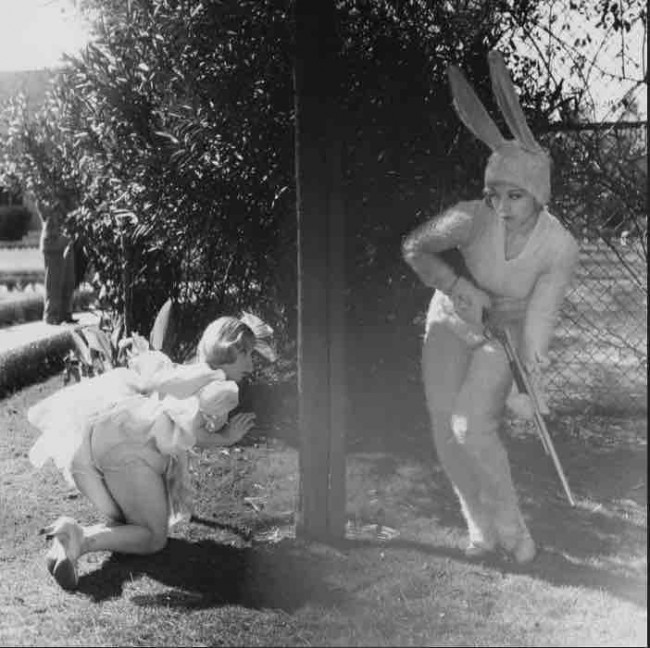
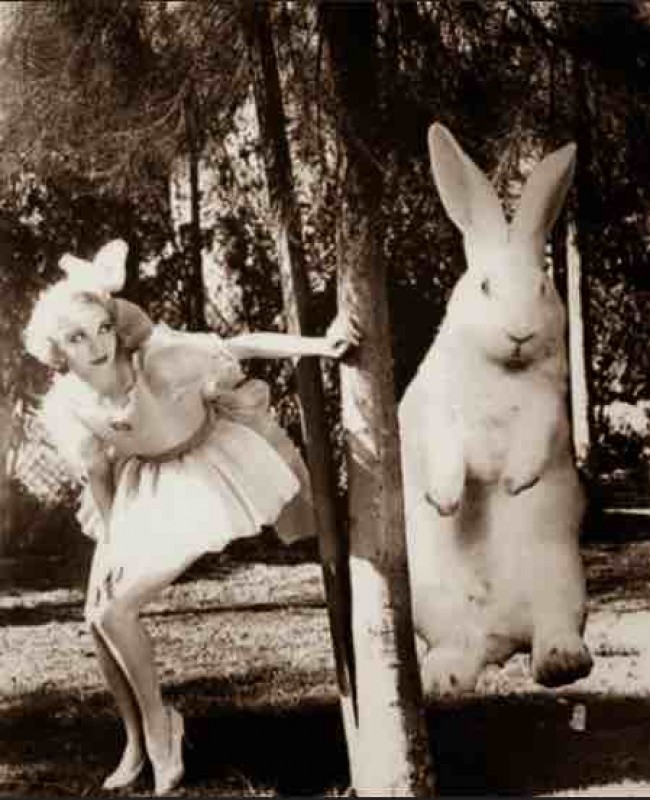
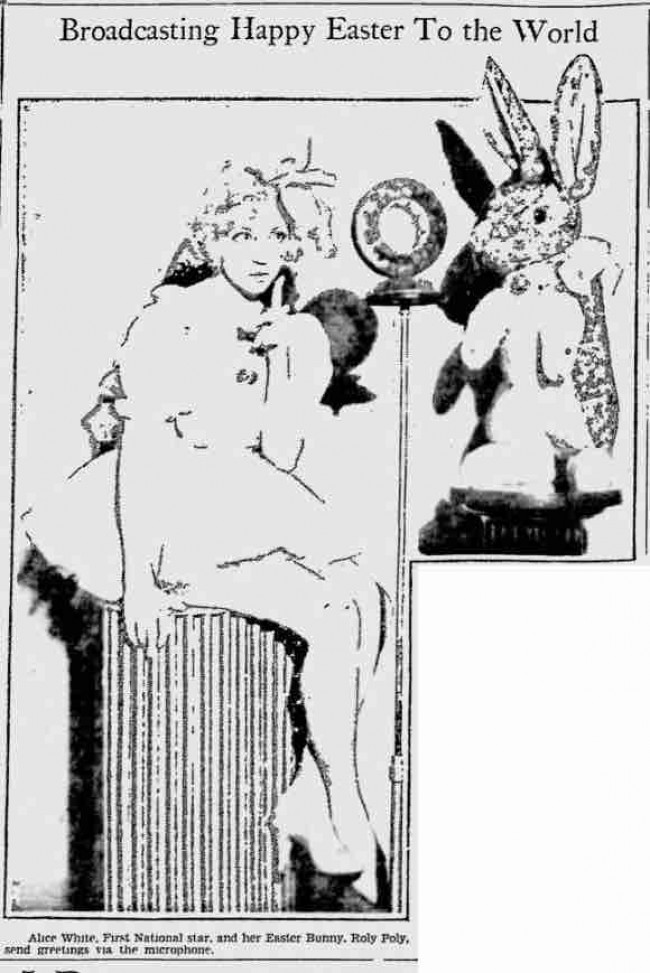
I am not sure why 1930s actress Alice White was made to pose with bunnies so often, but she certainly looked fetching with them.
Source of third foto.
Posted By: Paul - Thu Jan 12, 2017 -
Comments (7)
Category: Animals, Anthropomorphism, Movies, Publicity Stunts, 1930s
Anti-Cow Kicker
October 1938: Alice Anthony models an "anti-cow kicker" invented by Bill Vernia of Odebolt, Iowa.
Pittsburgh Press - Oct 16, 1938

The Franklin News-Herald - Oct 7, 1938
Posted By: Alex - Wed Jan 11, 2017 -
Comments (6)
Category: Inventions, Cows, 1930s
Hardware Diet
March 1934: Forty-year-old Mabel Wolf of Brooklyn showed up at Kings County Hospital complaining of acute stomach pain and a loss of appetite. An x-ray revealed the presence of a large clump of metallic objects in her stomach. In a subsequent hour-long operation, surgeons removed 1,203 pieces of hardware from her stomach. The objects weighed a total of one pound, three ounces. Amazingly, they hadn't done her any serious harm.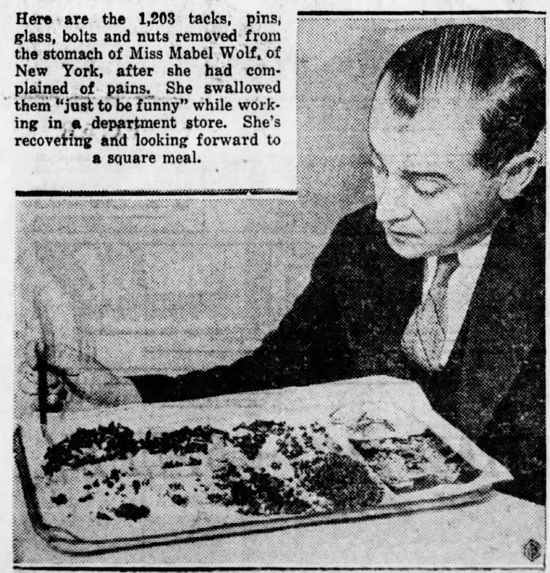
Lebanon Evening Report - Mar 21, 1934
The inventory of items removed included:
- 584 fine upholstery tacks
- 144 carpet tacks
- 2 chair tacks
- 1 roundheaded thumbtack
- 3 thumbtacks (ordinary)
- 46 small screws
- 6 medium screws
- 80 large screws
- 1 hook-shaped screw (coat hanger)
- 30 small bolts
- 47 larger bolts
- 3 picture hooks
- 3 nuts
- 2 large bent safety pins
- 1 small safety pin
- 2 stray pins without heads
- 1 matted mass of hair containing screws and pins
- 59 assorted beads
- 4 pieces of wire
- 89 pieces of glass (all sizes)
- 1 piece of teacup handle
Miss Wolf claimed that she had eaten all the objects five years earlier, in a single week, while she had been working at a Manhattan hardware store. (You have to wonder if the store had noticed the loss of inventory.)
When pressed further, Miss Wolf said, "I really don't know what started me on my diet. I guess I was just trying to be funny. Don't ask me any more about it. I only want to get well and go home."
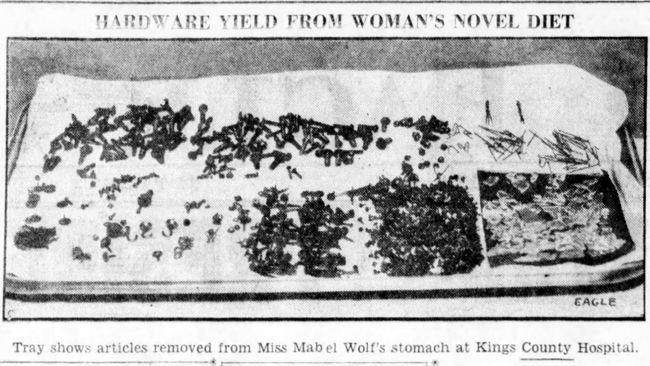
Brooklyn Daily Eagle - Mar 20, 1934
Miss wolf had suffered minor stomach pains for five years as a result of the objects, but she had been able to self-treat the discomfort with patent medicine. She finally went to a doctor when the pain became too intense.
One mystery that the doctors weren't fully able to explain was why the metal objects all clumped together in her stomach. Dr. Edwin H. Fiske speculated that "metallic objects in the stomach take on a kind of magnetism, which attracs the individual objects to one another, so that they cling together in one large ball, as if welded together. Thus the danger of the cuts from pointed nails and pins is lessened."
Evidently Miss Wolf suffered from the eating disorder known as pica, which is a compulsion to eat non-nutritive items such as paper, metal, chalk, mud, etc. I suspect that her strange diet hadn't been confined to a single week. She'd probably been doing it for quite a while.
We've previously posted about a few other people who suffered from this disorder, including the boy who ate the Bible and the Human Ostrich.
If you're interested in the subject of pica and people swallowing weird things, you can find a whole bunch of cases discussed (including Mabel Wolf) in Swallow: Foreign Bodies, Their Ingestion, Inspiration, and the Curious Doctor Who Extracted Them by Mary Cappello.
Posted By: Alex - Fri Dec 30, 2016 -
Comments (3)
Category: Food, 1930s, Mental Health and Insanity
Tiny Town, PA
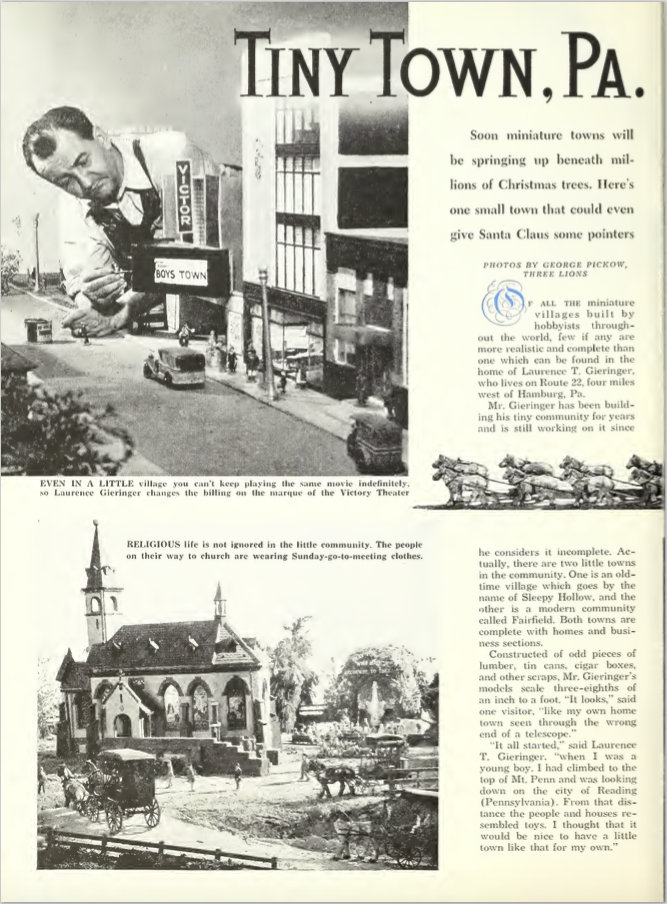
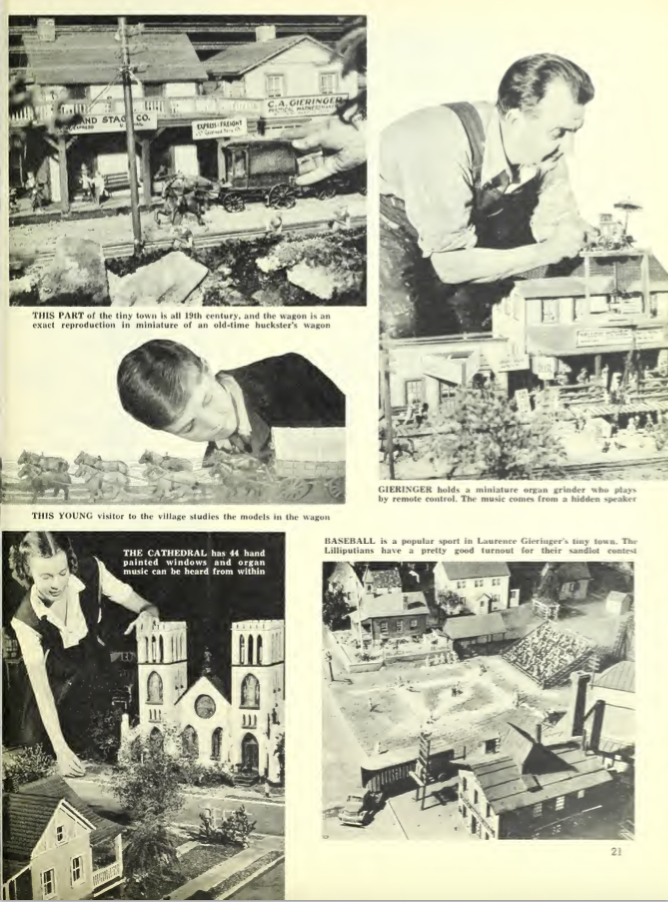
Homepage here.
News article here.
Posted By: Paul - Sat Dec 24, 2016 -
Comments (1)
Category: Eccentrics, Hobbies and DIY, Outsider Art, 1930s

| Who We Are |
|---|
| Alex Boese Alex is the creator and curator of the Museum of Hoaxes. He's also the author of various weird, non-fiction, science-themed books such as Elephants on Acid and Psychedelic Apes. Paul Di Filippo Paul has been paid to put weird ideas into fictional form for over thirty years, in his career as a noted science fiction writer. He has recently begun blogging on many curious topics with three fellow writers at The Inferior 4+1. Contact Us |




